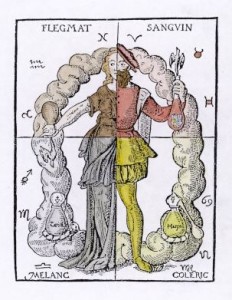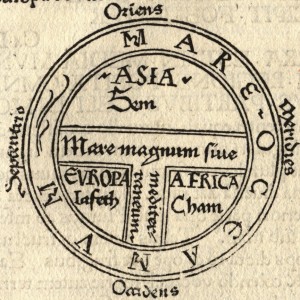Astonishment. This is the feeling I had when I came across this article, and the related link. My feeling is not among the five listed in Paul Ekman’s Atlas of Emotions, thus negligible, nevertheless I feel the urge to talk about my reaction.
This modelization suddelly reminds me the that of humoralism, in the way it was defined when it made its last comeback in the eighteenth century after being conceived by Egyptian and Greek medicines (especially by Hyppocrates and Galen).
Humoralism is both an etiologic theory of disease and a theory of personality: the personal disposition to excess in one of the four humors defines a character and together a complexion:
– the choleric, exceeding in yellow bile, is thin, dry, well-colored, irritable, touchy, clever, generous and proud;
– the melancholic, redundant of black bile, is thin, weak, pale, covetous, sad;
– the phlegmatic, exceeding in phlegm, is happy, slow, lazy, peaceful and talented;
– the sanguine, redundant of blood, is ruddy, jovial, cheerful, greedy and addicted to a playful sexuality.
Almost needless to say, the theory was abandoned as a scientific medical-psychological approach spread. Humoralism worked because there was no better explanation for one’s behavior. It was simple, solid, and it derived from the tendency that between fifteenth and eighteenth century produced formalization trying to cope with flows, be them acqueous, sanguineous or oleic.
Human love trying to gain simple understanding. In 1812 the French matematician Pierre-Simon Laplace wrote in his Essai philosophique sur les probabilités (the excerpt comes from the translation by Frederick Wilson Truscott and Frederick Lincoln Emory, entitled A Philosophical Essay on Probabilities and published by Dover, New York, in 1951):
An intellect which at a certain moment would know all forces that set nature in motion, and all positions of all items of which nature is composed, if this intellect were also vast enough to submit these data to analysis, it would embrace in a single formula the movements of the greatest bodies of the universe and those of the tiniest atom; for such an intellect nothing would be uncertain and the future just like the past would be present before its eyes.
Science was progressing at such a pace that the idea of this “demon” (hence called “Laplace demon”) could sound somehow achievable. A huge calculator able to perform such forecasts was to be built, someday.
Today, scientists do not believe this “intellect” may ever exist. How can they be so sure? Because Nature, fortunately, works in a non-linear manner. Which, on its turn, means that a certain input on a system in a certain state does not always lead to the same output. Or, more precisely, that slight modifications in the starting conditions generally lead to more than significant differences in the final state of the system.
Be it said, all this happens when we have an accurate knowledge of the system; but what if the information required is censored by the system itself? Indeed this is what human mind does: it stores some information in a way that makes it inaccessibile to our consciousness. This fact, called repression, should be well known since Freud’s work, and is the reason why we are not capable to analyze ourselves in a complete way. We are not able to detect triggers because we simply do not have conscious clues about them.
Human mind structure may lead to actions – I refer to the word as it is used in the Atlas – which are not those foreseen by the Atlas itself. Due to anger, one could physically assault somebody else, thus determining an unexpected behavior. Unexpected not only by the assaulted, but also by the assaultant, as the latter has no way to consciously know the trigger leading to such action, thanks to the work of superego. Only a shrink can help, starting a five-years process which will clarifiy the root causes for that behavior. But even after a psychoanalytic treatment, no one is be able to determine if, once set a certain stage, in a specific moment the threshold causing that behavior will be exceeded or not. No model can be deterministic and predictive.
If an atlas is our aim, what we can get at best is a “T and O map”. If mastering our emotions is our goal, luckily this is not possible as completely as proposed. We survived and evolved because we cannot completely control ourselves. When needed, we behave almost unconsciously (e.g., in case of severe personal danger). A largely diffused essay such as Malcolm Gladwell’s Blink gives some useful examples of this process.
I am not saying we are not supposed to try to know ourselves better, to improve ourselves, to get the best from ourselves. On the contrary, personal improvement should constantly drive us amid the events we encounter. Bur trying to modelize in such narrow frameworks the amplitude and the degrees of our emotions is, in my opinion, useless.
Unless we have a contemplative life such as, as an example, that of… the Dalai Lama. Deepening one’s knowledge is possible, yes, only through long time devoted to self assessment (the term is deliberately used). The Atlas, though, is not intended to be used only by cloistered monks, yet by western workers. But they cannot just use it.
Resuming:
- modelizing human emotion sounds a little outdated;
- it is also pretty useless, as the spectrum of human feelings well surpasses the some dozens listed in the Atlas;
- Nature’s complexity outscores our ability to control events;
- factors triggering our emotions are often non-conscious (inconscious or subconscious);
- a non-monk has no chance to deepen his or her own self-knowledge in the terms proposed by the Atlas without help from specialized professionals;
- a short scheme is more marketable than a long essay.


